
Home - AFV Events - Other AFV Events - EVS-20 Public Days

Well, rereading the last few articles I've posted about fuel-cell vehicles (FCVs) on this website, I have sounded pretty negative about the likelihood that automakers will actually follow through on their statements of commitment. While I still intend to keep the heat on them every chance I get, after going to the public days at the 20th Electric Vehicle Symposium (EVS-20) in Long Beach on 16 November 2003, I have to say that I feel a bit better about the long-term prospects. The Electric Drive Transportation Association (formerly the Electric Vehicle Association of the Americas) holds an EVS every year, from Beijing to Washington, DC; this year it was right down the freeway from me in Long Beach, so I went to one of the two public days, where I talked with a lot of people in the exhibit hall and got into as many vehicles in the ride-and-drive outside as I could before the exhibition closed. Every vehicle you see in the photo above has a hybrid-electric, battery-electric, or fuel-cell drivetrain, from the battery-electric Toyota RAV4-EV in the foreground (one of several 100,000-mile RAV4-EVs brought here by Southern California Edison) to the buses on the right.
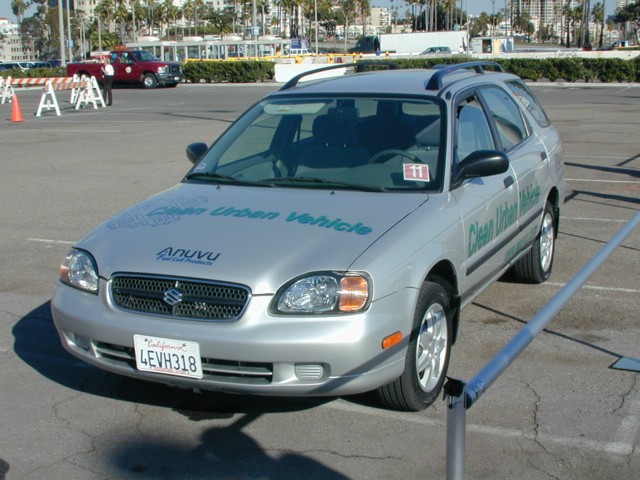
I spent some time talking with Ken Koch, founder of KTA Services, at the Advanced DC Motors booth; I was very happy to meet him, as I had learned most of what I know about electric-vehicle (EV) conversions and components from his company's catalog. I also ran into my old friend Rick Ostrov in the GM area; he was involved in the EV1 project from the start. However, I spent the most time speaking with (okay, grilling!) Rex Hodge, president of Anuvu (pronounced "a new view"), which is offering for sale the first fuel-cell vehicle available to the public. The Anuvu CUV (Clean Urban Vehicle) has a 12 kilowatt (about 16 HP) fuel cell, with a 100 kW electric motor; it also has a battery pack that's bigger than the typical "buffer" pack in a gasoline hybrid-electric vehicle (HEV), or in other fuel-cell prototypes. The vehicle's range is 250 miles around town on a fill-up of hydrogen, which is more than a lot of gasoline vehicles; it's designed for as much around-town driving as a fleet vehicle could possibly need to do in a day. It is also freeway-capable, but since freeway driving consumes more power than the small fuel cell can produce, the battery pack limits the range; the CUV can go 60 miles, then needs some time for the fuel cell to recharge the pack before going further. It can also be recharged from wall-plug electricity, which is a lot cheaper than hydrogen; and in a couple of years they hope to double the fuel cell output without raising the price, which would give it enough power to run continuously on the freeway until it runs out of hydrogen. Oh, and the price? Well, unlike the other million-dollar prototypes in the ride-and-drive, if you can afford a Hummer H1, you can now afford an FCV (are you listening, Gov. Schwarzenegger?); and if they can get production volumes up to a few hundred per year, they figure they can pull the price down to Hummer H2 levels. I rode in the testing "mule" pictured above, based on a wagon that's now out of production; the vehicles offered for sale are based on Nissan 2- and 4-door pickup trucks.
What I spent so much time talking to him about was the commitment to fuel cells of automakers and energy companies. The energy companies, in his estimation, are serious about finding a business model to carry them beyond the end, whenever it comes, of cheap petroleum; he quoted an energy research official in Europe who said that oil companies there would rather spend money to put hydrogen refueling stations all over the continent than to reduce the level of sulfur in their gasoline, because they think they wouldn't be able to sell enough gasoline in the future to recoup their investment in the de-sulfurization equipment. Of course, pressures on the gasoline market in Europe, in particular these countries' commitment to the Kyoto greenhouse-gas reductions, are different from those in the U.S.; however, questions of the ability of petroleum supply to keep up with ever-increasing demand as (for example) the Chinese market grows, are global. We don't have to "run out of oil" for hydrogen and other energy carriers to be attractive--we just have to run out of cheap oil, which is guaranteed if production can't be expanded enough at current prices to keep up with increasing demand. The automakers, in turn, seem more enthusiastic about FCVs than they ever were about battery EVs; this would be expected if they foresee a shift away from petroleum fuel coming, and want to be ready to sell into that market. Anyway, as an observer (unlike me) with a professional interest in the subject, Mr. Hodge thinks the current increase in interest is real, not just a "Wimpy" scheme (after the character in "Popeye" whose classic line was "I will gladly pay you Tuesday for a hamburger today") that promises FCVs in the future in order to avoid being required to make EVs or HEVs today. We'll see; in the meantime, Anuvu figures to break the "chicken and egg" dilemma by offering FCVs that can take advantage of urban hydrogen refueling stations as they come online, in turn providing vehicles to buy the fuel to encourage building of more stations.
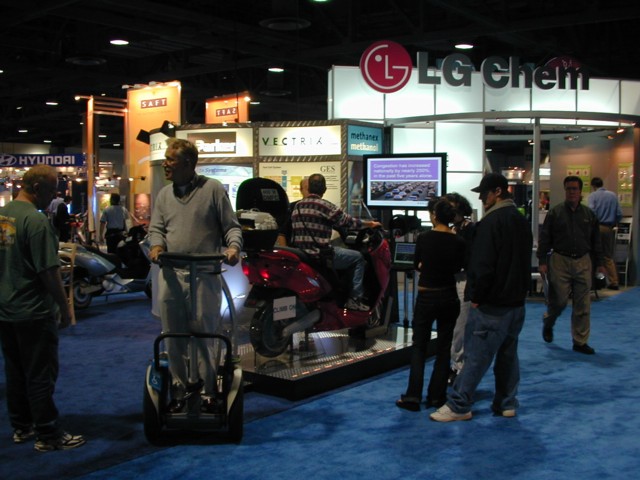
Here's a similar kind of a design: this Vectrix scooter is a battery EV, capable of being plugged into utility electricity, but the "backpack" behind the seat is a small direct methanol fuel cell that can recharge the batteries on the fly to increase range. They expect to sell these vehicles starting in a couple of years. And yes, that is a Segway transporter being (ridden? driven?) by the gentleman on the left.
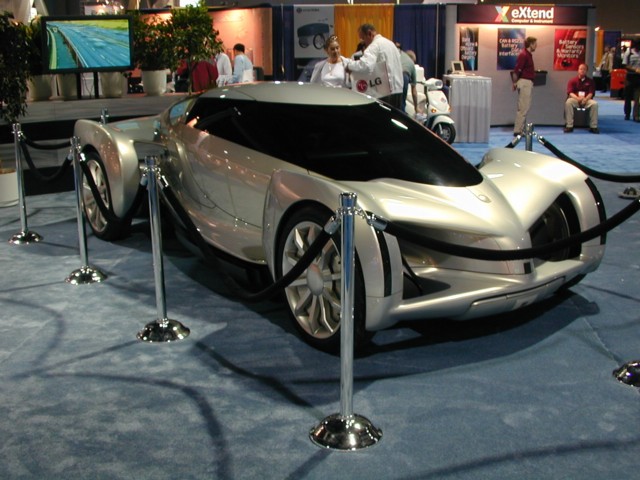
In the GM area was the Autonomy fuel-cell concept vehicle. A year ago, at the Anaheim Auto Show, I saw a mockup of the "skateboard" chassis that contains the entire drivetrain and control electronics; this is one of the possible bodies that can be mated to the chassis. Unlike the mockup I saw in Anaheim, I understand that this is the driveable version, which I had not seen before except in photos.
Outside in the ride-and-drive area was the GM HydroGen3, an FCV based on the European Opel Zefira minivan. I mentioned above that I rode in the Anuvu CUV; Ford also was only allowing visitors to ride in their vehicles (I don't know about Honda), but GM actually let me drive this million-dollar prototype around the block! Among the vehicles at the ride-and-drive were some production hybrids, including the new 2004 Toyota Prius; the longest lines I saw were for the Prius. I guess people wanted to check out a vehicle they might be thinking of buying, but heck, they could've gone to their local Toyota dealers! Well, I didn't mind, as it made the lines for the far more unusual fuel-cell vehicles that much shorter. By the way, the HydroGen3 is the first FCV I've heard of that doesn't have a battery pack as a buffer to absorb energy as the vehicle slows down (regenerative braking) and to provide an extra boost when a lot of power is needed; most FCVs are "fuel cell hybrids" that, like gasoline HEVs, have a battery pack (or ultracapacitor, or other energy storage mechanism) to let the primary power source (fuel cell or gasoline engine) be smaller and therefore cheaper and more efficient. I didn't even know that non-hybrid FCVs existed until I drove this one!

There were a number of gasoline HEVs in the exhibit hall, in addition to the U.S. production models out in the ride-and-drive. The first vehicle I saw when I entered was the hall was this Nissan cube e-4WD; it is a production model in Japan (not available in the U.S.) which has a gasoline engine driving the front wheels and an electric motor driving the rear wheels to give all-wheel drive capability without a power-wasting transfer case.

Next to the Autonomy, GM displayed a cutaway of their 2004 mild-hybrid pickup truck. Here's the engine and transmission, displayed separately; the electric starter/generator is integrated with the flywheel and torque converter, between the engine and transmission. The vehicle gets about 10-15 percent better fuel economy than a pickup with the standard 5.3-liter drivetrain, but it's mainly being promoted as a "contractor special" with integrated 110-volt outlets and reduced operating costs, rather than as an environmental vehicle. They say it will be released with "limited availability" in spring 2004.
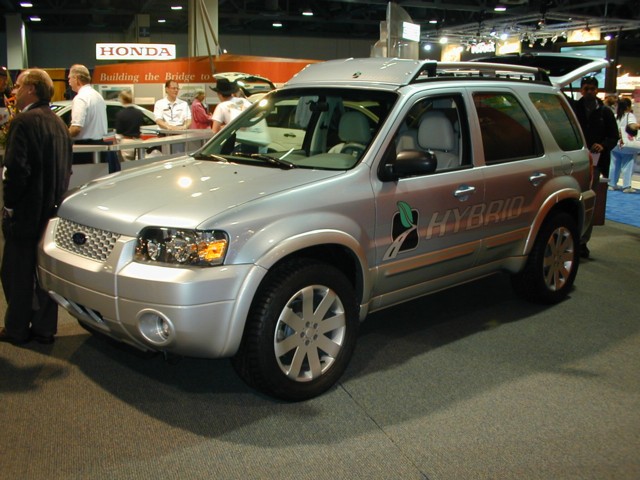
Ford has delayed release of the HEV version of their Escape compact SUV, but it is on the way, and this production prototype was on display in the exhibit hall. Ford also had various hydrogen fuel-cell and internal-combustion-engine vehicles out in the ride-and-drive.

There were a few battery EVs present, but almost all of them were Neighborhood Electric Vehicles (NEVs), small 25 MPH EVs that are legal (in many states) on streets with speed limits no higher than 35 MPH. These two are a smart coupe modified by ZYTEK to be an EV, and an NEV from ZAP. Both vehicles' makers say that they are ready to promote these vehicles from NEVs to full-function EVs; ZYTEK decided to start with an NEV because it is cheaper to get a vehicle certified to NEV standards than to full Federal motor-vehicle safety standards, and ZAP says that they are waiting for computer-simulated crash tests to be accepted for safety certification (they're a lot cheaper than physical crash tests).
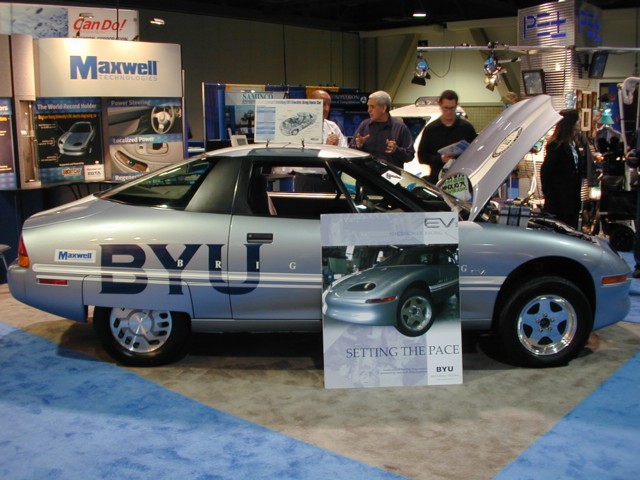
And, much to my surprise, there was an EV1 present! When GM ended the last EV1 leases and started taking the vehicles back from their drivers, a few went to schools with advanced-transportation research programs. Brigham Young University replaced the battery pack with a bank of Maxwell ultracapacitors; these don't hold a lot of energy, so range isn't very good, but they can discharge it at a very rapid rate, producing more power than batteries could survive. This makes them ideal for racing.
Well, I'm posting this report on the last day of 2003. This was the year in which, according to the California Zero Emission Vehicle (ZEV) rules up to a year or so ago, 10 percent of vehicles sold in California were supposed to be ZEVs. According to the current rules, the battery EVs that would have been needed to meet these regulations have been replaced with some additional extra-clean gasoline vehicles, plus promises of FCVs in the future. The "Super Ultra Low Emission Vehicles," those clean gasoline vehicles, will get dirtier over time as their emission-control equipment and calibrations wear; we'll have to keep the pressure on automakers, energy companies, and the government to ensure that the fuel-cell vehicles, and enough emission reductions to make up for the extra pollution from the replacement of battery EVs by gasoline vehicles, become a reality instead of another broken promise.
 Back
to AFV Events Page
Back
to AFV Events Page Back
to Fueling Station
Back
to Fueling Station Site
Map
Site
Map Contact
Me
Contact
Me All content copyright 1998-2024 by Mark Looper, except as noted. Reuse of my copyrighted material is authorized under Creative Commons Attribution 4.0 International license (CC BY 4.0).
![]()
![]()
new 11 September 2002, revised 31 December 2003